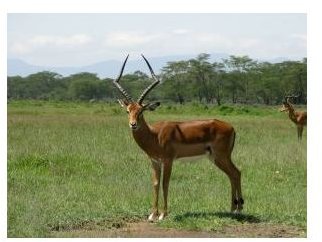How Adaptations of Gazelles Help These Herbivores Cope with their Environment and the Pressures of Being a Prey Species
Diet of Gazelles
Gazelles are herbivores. Their precise diet varies with their habitat as they are found in grasslands, deserts, and mountain landscapes. Their diet changes seasonally to take advantage of available resources. Water is a limited resource in their habitat, which requires that gazelles use water efficiently. Plants will provide some moisture content.
Gazelles conserve water by concentrating their urine. Their feces are also relatively dry to prevent unnecessary loss. Behavior adaptations provide additional ways for gazelles to maximize their water intake. Some species will feed during the early morning or evening hours rather than the heat of the day. At this time, the water content of the plants they graze on has the highest available moisture content.
Physical Adaptations
The adaptations of gazelles can be seen in the physical stature of these animals. Their medium size means less skin area for excess moisture loss through evaporation. Their long limbs allow them to sprint rapidly out of the range of predators. The Thomson’s gazelle can reach speeds up to 40 miles per hour, according to National Geographic. This ability is vital for animals subject to predation by cheetahs, the fastest land animal.
Their tan coloration helps gazelles blend in with their environment, making them more difficult to spot by predators. It is a subtle, yet effective form of camouflage. For prey species, any competitive edge a gazelle may have is to its advantage.
Behavior Adaptations
Several species-specific behaviors provide additional examples of adaptations of gazelles. These adaptations allow gazelles to conserve energy and resources. This is an important feature, especially considering the harshness of their environment.
Like many animals, gazelles use gestures and certain postures as warning communication in order to prevent conflict. Fighting between animals uses energy. It also presents a chance of injury, possibly resulting in an impairment of food gathering and defense against predators.
Gazelles live in male-led herds, with the size varying with the species. Herding is adaptive behavior in prey species. Living in a group affords some protection against predators. Predators may lose track of a targeted animal as like-colored animals scatter. A herd means that more eyes are keeping an eye out for a possible attack. A single animal is more likely to be spared when living in a group rather than on its own during an ambush.
Some species of gazelle are nomadic, following seasonal patterns in plant growth. They may occupy an area as long as food supplies are plentiful. This behavior allows them to maximize the available resources for growth and development.
The many adaptations, both physically and behaviorally, in gazelles help them cope with their harsh environment. As a prey species, these adaptions help ensure that some animals will survive to the next generation.
References
Estes, Richard. The Behavior Guide to African Mammals: Including Hoofed Mammals, Carnivores, Primates. 1992
David MacDonald. The Encyclopedia of Mammals. 2009
National Geographic: Thomson’s Gazelle – animals.nationalgeographic.com
Photo by John Beckett- https://www.sxc.hu/photo/1062086
